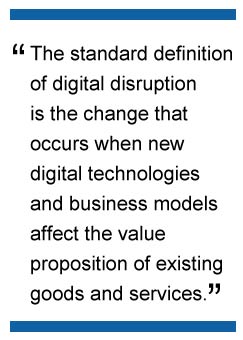Data is the driving force for the way we work, play, and interact with each other, so much so that it has led one writer to call this age of digital disruption and innovation our era’s version of the Industrial Revolution, adding that we are living in what may be the “most transformable” period in all of history. This digital disruption is changing how we do just about everything.
Digital Disruption Definition

The front runners in our most current round of digital disruption are mobile and the Internet of Things (IoT), according to Bill Bodin, CTO at Kony, Inc.
“With mobile, we now have an expectation for enterprise to deliver multi-channel solutions,” Bodin says. “Employees and consumers alike expect a premium experience no matter what device they’re using. With the IoT, we see distributed computing and applications taken to a new level of convenience and personalization.”
How to Tackle Digital Disruption
Digital disruption affects the enterprise by forcing a wholesale change of existing processes and technologies or in creating entirely new operational models.
“Automotive companies have created cabins which are now interactive and in many ways dependent on mobile devices. Railways track inventories, speed and safety in real time. And health care with personal mobile monitoring is now extending the quality and length of lives,” says Bodin. “These scenarios and many more are wrapped in security implications and privacy concerns, but all these concerns are addressable when each solution is developed with a platform that combines strong client security with solid back end service safeguards.”
Enterprises should see digital disruption as an opportunity, Kevin Strohmeyer, senior director of product marketing, Workspace Services, VMware, adds. “There is a new wave of process automation possible when information is collected or transactions are made in the moment. As a result, we could see fewer and fewer process jobs, freeing the enterprise to invest its human capital where it counts, at the point of value.”
Digital disruption creates a complete end-to-end change in how you do business. For the so-called legacy players, such as those in the telecoms industry, these changes have produced an unfamiliar digital landscape and are forcing a change in how to become digital players in this new ecosystem.
“This is why the need for a standardized and common language will become increasingly important from a business, technology, and marketplace perspective,” says Craig Bachmann, senior director of the Open Digital program at TM Forum.
The IoT (or as Bachmann called it, IoE, Internet of Everything) is a driving force behind the digital disruption, providing a limitless opportunity to innovate and create disruptive technology services and products.
“One of the biggest opportunities for disruption in the realm of IoE is determining how to monetize it,” says Bachmann. “New IoE business models lack the simplicity of traditional pipeline supply chains, and as technology provides a digital set of capabilities to overlay complex business models, we will see significant changes brought on by new ways of doing business.”
Expect the IoT (or IoE) to become an even more integral part of digital disruption as technology advances. There will be more sensors, more data collected, and increasingly smarter results based on all of this information. But while this presents unprecedented opportunity for enterprise use, there will remain the need to be aware and vigilant of this vast amount of information.
Understanding how to manage the flow of data from the IoT is one of the challenges of digital disruption. While new technologies have the ability to change the way we work for the better, Paul Rigby, SVP, Business Operations with Vitalyst Response, explains, many enterprises often struggle to see the full value of these tools because employees do not have the motivation, and more importantly, the skills and proficiency necessary to fully utilize those tools. Tech can disrupt work in a negative way just as much as it can positively.
“When this happens, productivity is hindered, collaboration falters, and business goals go unmet,” Rigby says. “Once motivated to take a step into a digital direction, enterprises must lay the right foundation to enable employees to maximize their productivity potential by giving them access to training and learning, self-help resources and how-to support so they can better understand and optimize the tools at their disposal.”
The move to digital has the power to unlock the full potential value of data. However the desire to gather, utilize and store all of this data comes with the risk that this data can be stolen.
“In fact, not only will the volume and range of new data used and stored by enterprises put pressure on existing security technology and practices, but that same increase in data quantity and value will actually provide even greater incentives for attackers to steal information,” says Geoff Webb of Micro Focus. “If at its heart digitalization increases the value of data, and it does, then it also acts as a siren song to hackers who will want that very same data.”
Digital Disruption to Revolutionize Business
Despite the challenges, digital disruption is set to revolutionize business. The best way to leverage disruptive digital opportunities, says Webb, is to take a systematic approach to evaluating how to move from simply “running IT more efficiently” to really driving disruptive change in the business.
“The time for the CIO to assert control and drive meaningful business change is now,” Webb says. “Digitalization presents the path to directly and deeply connect with customers, and to more fully understand how to deliver value to the customers you have.”
Sue Marquette Poremba has been writing about network security since 2008. In addition to her coverage of security issues for IT Business Edge, her security articles have been published at various sites such as Forbes, Midsize Insider and Tom’s Guide. You can reach Sue via Twitter: @sueporemba


